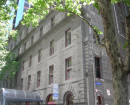MEMORIAL HALL
147 COMMERCIAL ROAD KOROIT, MOYNE SHIRE
-
Add to tour
You must log in to do that.
-
Share
-
Shortlist place
You must log in to do that.
- Download report
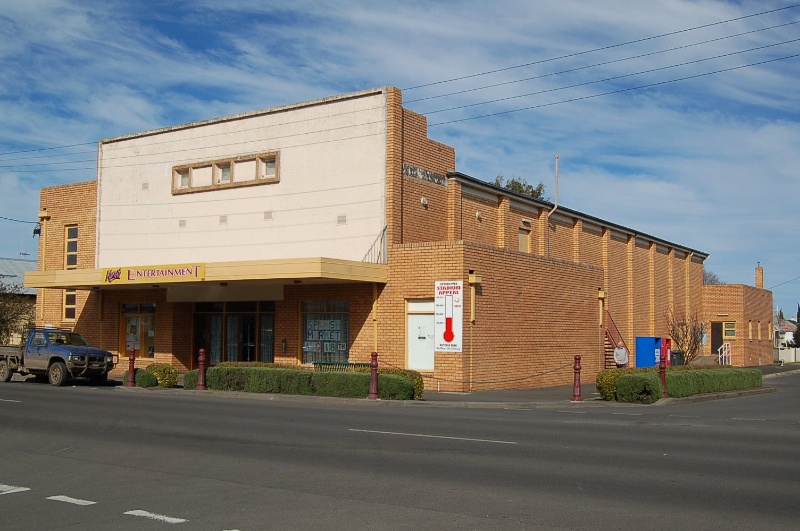

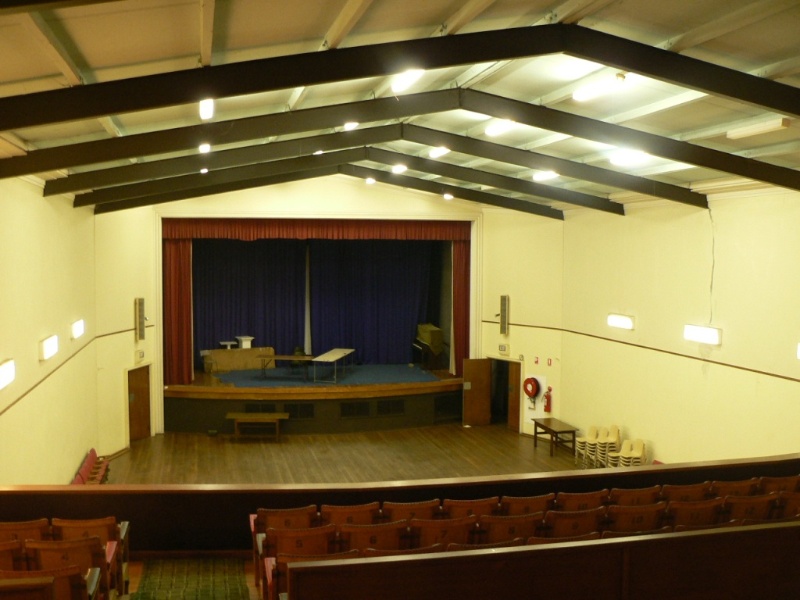

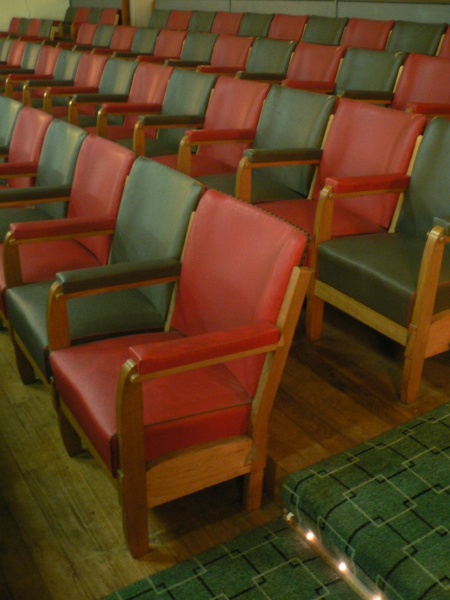
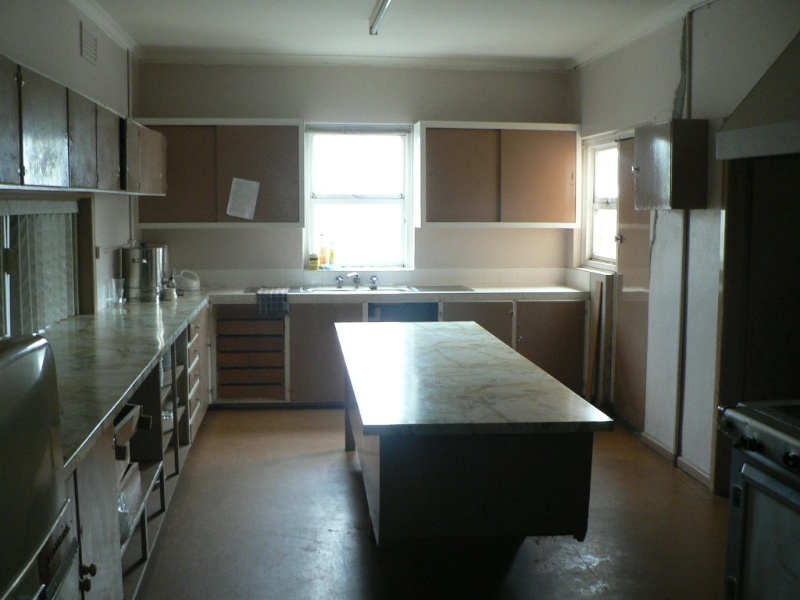
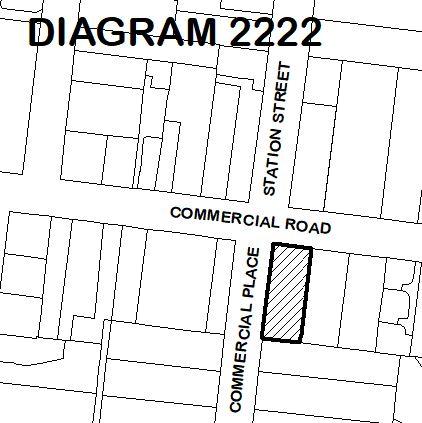














Statement of Significance
What is significant?
The Memorial Hall, Koroit, constructed in 1957 as a multi-use complex with full cinema and entertainment facilities including original projection and sound equipment. Significant elements include the exterior and interior features, including the stainless-steel candy bar, original seating, carpet and lino, light fittings, signage, heating and other services, box office, kitchen fixtures and architectural detailing as well as its original seating as well as projection, sound and related equipment, as well as glass advertising slides (held at the Koroit Historical Society).
How is it significant?
The Koroit Memorial Hall is of architectural, and historical significance to the State of Victoria. It satisfies the following criterion for inclusion in the Victorian Heritage Register:
Criterion A - Importance to the course, or pattern, of Victoria's cultural history.
Criterion B - Possession of uncommon, rare or endangered aspects of Victoria's cultural history.
Criterion D - Importance in demonstrating the principal characteristics of a class of cultural places and objects.
Why is it significant?The Koroit Memorial Hall and the objects integral to the place are significant at the State level for the following reasons:
The Memorial Hall, Koroit is historically significant as one of the last purpose-built cinemas in rural Victoria. The Hall is also significant for its association with the Catholic church and for its demonstration of the moral and spiritual influence the church exerted on the lives of Catholics in that period. [Criterion A]
The Memorial Hall, Koroit is architecturally significant as an outstanding late example of the work of Cowper Murphy & Associates, one of the most important and prolific firms of cinema architects in Australia. Its high degree of integrity, including a stainless-steel candy bar, original seating, carpet and lino, light fittings, signage, heating and other services, box office, kitchen fixtures and architectural detailing, is unusual and rare. It is also of note as possibly the largest building of several constructed at this time using portal frame construction. [Criteria B and D]
The Memorial Hall, Koroit is significant as a mid-century cinema for its retention of its original seating as well as projection, sound and related equipment, and glass advertising slides. These objects add to an understanding of the cinema's operation. [Criterion D]
-
-
MEMORIAL HALL - History
The Memorial Theatre, Koroit is situated in the middle ofthemainshoppingstrip of Koroit. It was built for the Catholic ChurchwithJ.P. O'CollinsDD, Bishop of Ballarat laying the foundation stoneon2ndJune 1957. Thearchitects were Cowper Murphy and Associates,themostprolific cinemaarchitects in Australia who were responsibleforatleast thirty newdesigns and major refurbishments (For a fulllistseeHeritage Matters PtyLtd, Jaffas Down the Aisle , 2008). The firm existed from the later 1920s until the mid1930swhenitbecame Cowper Murphy and Appleford, reverting to the formernamein1948.They had just completed a commercial cinema in PortFairy,nowcalled theReardon Theatre. The Koroit cinema is their lastknowncinemadesign andis probably one of the last single screen cinemasto bebuiltin Victoria,with the Shire of Heytesbury Town Hall completedin1965,the only knownlater example.The Borough of Koroit was very small, so it is not surprising that the notably Catholic community of Koroit with its hinterland built the hall. The principal parishes were: St Patrick's, Koroit; St Patrick's, Kirkstall; and St Brigid's, Crossley. Other Catholic halls with full cinema facilities were built in rural Victoria such as St Thomas's Hall, Terang, built in 1930 and the Cathedral Hall, Sale built in 1955. The architect for the former is not known. The architect for the latter, according to its foundation stone, was A E Avery. The Moyne Heritage Study states 'St Patrick's Hall, where pictures were shown from 1925, became increasingly crowded in the 1930s. In 1937, the Koroit Catholic Church had plans drawn up for a larger building, which would serve both as a picture theatre and for other community purposes. Due to difficulties with finance and the intervention of the War, commencement of the new theatre was delayed. In 1954, the Church proposed instead to purchase the Koroit Mechanics Hall for use as a theatre. This was rejected by the Trustees of the Mechanics Hall, however, as they believed it would be unsuitable for one section of the community to have control of a public building. . Building funds were raised mainly by the Koroit Young Christian Workers group. The building also serves as a memorial to those men of the Koroit Catholic Parish who were killed in the Second World War.' (Helen Doyle, 'Moyne Heritage Study, Stage 2', SITE ID: 2264)
Many 'memorial' theatres were built after both Wars, with the name possibly being used to attract government funding. For its quality and scale, the Memorial Theatre, Koroit is one of the most impressive post-World War Two examples of a multi-function hall although these were usually built by municipalities. The Memorial Halls at Willaura and Lake Bolac, built by the Shire of Ararat in the same year, 1957, are typical. Commercial cinemas, until the advent of television, were lucrative and helped pay for these substantial buildings. It must be remembered that TV did not reach western Victoria until the mid-1960s.
CATHS research states 'Over the years the Film Weekly Motion Picture Directory lists the exhibitor of films in Koroit as various Catholic Church connections. Three locations were used, the Koroit Mechanics Institute (600 seats) . the St Patrick's School Hall (230 seats) and finally the Memorial Theatre (408 seats)' (Kennedy, Cinema Record, Issue 7, April 1995). The original design was for a raked floor but, according to CATHS, 'the bishop insisted that a flat floor be built'.
The portal frame structure is notable. The system was introduced generally after World War Two and became possible because of the increased availability of suitable steel, its lower price and the engineering expertise in designing the critical junctions. It had been used at Cathedral Hall, Sale which was designed by a different architect and built two years before. It was also used at the Memorial Hall in Streatham which was built by public subscription in 1957 but not at the Port Fairy cinema designed by the same architects and built just a few years earlier. Importantly, the steel frames and the purlins supporting the roof are exposed as expressed structure. It is also notable for having very little auditorium space under the dress circle. The last single screen cinema to be built using portal frame construction was probably the hall which is part of the former Shire of Heytesbury municipal offices complex, completed in 1965.
The cinema screened films regularly on Wednesdays, Fridays and Saturdays into the mid 1960s when the advent of television had the usual effect on its custom. At a statewide level, the Catholic Church expressed a strong position on the censorship of popular films in the 1950s through the editorials and film reviews of the newspaper, The Advocate. It is not known certainly but there was probably some influence from the local clergy on the selection of films for screening and the times were generally conservative. By the mid-1960s the advent of television in south-western Victoria had changed popular entertainment utterly. The cinema The building was sold Moyne Shire in the 1990s. This has ensured its almost complete integrity with the dress circle completely intact, most of the projection equipment surviving and the ancillary areas such as the kitchen and supper room completely intact. The building remains available for public use but films are not screened although the rare projection equipment is turned on to ensure its viability.
References
Doyle, Helen with Context Pty Ltd, Moyne Shire Heritage Study, Site ID 2264
Kennedy, Gerry, Cinema Record, Issue 7, April 1995.
References (amendment)
KEY REFERENCES USED TO PREPARE ASSESSMENT
Doyle, Helen with Context Pty Ltd, Moyne Shire Heritage Study, Site ID 2264
Kennedy, Gerry, Cinema Record, Issue 7, April 1995.
Heritage Matters Pty Ltd, Jaffas Down the Aisles - A study of Cinemas in Country Victoria, June 2008
ACKNOWLDEGEMENTS
Richard Twentyman, Cinema and Theatre Historical Society of Australia Inc., (CATHS)
John Gunn, Committee of Management, Koroit Theatre
Jacqueline Anderton, Moyne Shire
MEMORIAL HALL - Plaque Citation
A late design by prolific cinema architects Cowper Murphy and Associates, this multi-purpose venue with full cinema facilities was built in 1957 for the Catholic community. It also serves as a Second World War memorial.
MEMORIAL HALL - Assessment Against Criteria
Criterion
Criterion A: Importance to the course, or pattern, of Victoria's cultural history.
Criterion B: Possession of uncommon, rare or endangered aspects of Victoria's cultural history.
Criterion D: Importance in demonstrating the principal characteristics of a class of cultural places and objects.The Koroit Memorial Hall and the objects integral to the place are significant at the State level for the following reasons:
The Memorial Hall, Koroit is historically significant as one of the last purpose-built cinemas in rural Victoria. The Hall is also significant for its association with the Catholic church and for its demonstration of the moral and spiritual influence the church exerted on the lives of Catholics in that period. [
Criterion A]
The Memorial Hall, Koroit is architecturally significant as an outstanding late example of the work of Cowper Murphy & Associates, one of the most important and prolific firms of cinema architects in Australia. Its high degree of integrity, including a stainless-steel candy bar, original seating, carpet and lino, light fittings, signage, heating and other services, box office, kitchen fixtures and architectural detailing, is rare. It is also of note as possibly the largest building of several constructed at this time using portal frame construction. [Criteria B and D]
The Memorial Hall, Koroit is significant as a mid-century cinema for its retention of its original seating as well as projection, sound and related equipment, and glass advertising slides. These objects add to an understanding of the cinema's operation. [
Criterion D]
MEMORIAL HALL - Permit Exemptions
General Exemptions:General exemptions apply to all places and objects included in the Victorian Heritage Register (VHR). General exemptions have been designed to allow everyday activities, maintenance and changes to your property, which don’t harm its cultural heritage significance, to proceed without the need to obtain approvals under the Heritage Act 2017.Places of worship: In some circumstances, you can alter a place of worship to accommodate religious practices without a permit, but you must notify the Executive Director of Heritage Victoria before you start the works or activities at least 20 business days before the works or activities are to commence.Subdivision/consolidation: Permit exemptions exist for some subdivisions and consolidations. If the subdivision or consolidation is in accordance with a planning permit granted under Part 4 of the Planning and Environment Act 1987 and the application for the planning permit was referred to the Executive Director of Heritage Victoria as a determining referral authority, a permit is not required.Specific exemptions may also apply to your registered place or object. If applicable, these are listed below. Specific exemptions are tailored to the conservation and management needs of an individual registered place or object and set out works and activities that are exempt from the requirements of a permit. Specific exemptions prevail if they conflict with general exemptions. Find out more about heritage permit exemptions here.Specific Exemptions:General Conditions: 1. All exempted alterations are to be plannedandcarried out in a manner which prevents damage to the fabric oftheregistered place or object. General Conditions: 2. Should it become apparent during further inspection or the carrying out of works that original or previously hidden or inaccessible details of the place or object are revealed which relate to the significance of the place or object, then the exemption covering such works shall cease and Heritage Victoria shall be notified as soon as possible. Note: All archaeological places have the potential to contain significant sub-surface artefacts and other remains. In most cases it will be necessary to obtain approval from the Executive Director, Heritage Victoria before the undertaking any works that have a significant sub-surface component. General Conditions: 3. If there is a conservation policy and plan endorsed by the Executive Director, all works shall be in accordance with it. Note: The existence of a Conservation Management Plan or a Heritage Action Plan endorsed by the Executive Director, Heritage Victoria provides guidance for the management of the heritage values associated with the site. It may not be necessary to obtain a heritage permit for certain works specified in the management plan. General Conditions: 4. Nothing in this determination prevents the Executive Director from amending or rescinding all or any of the permit exemptions. General Conditions: 5. Nothing in this determination exempts owners ortheir agents from the responsibility to seek relevant planning orbuilding permits from the responsible authorities where applicable. Minor Works : Note: Any Minor Works that in the opinion of the ExecutiveDirector will not adversely affect the heritage significance of theplace may be exempt from the permit requirements of the Heritage Act. Aperson proposing to undertake minor works may submit a proposal to theExecutive Director. If the Executive Director is satisfied that theproposed works will not adversely affect the heritage values of thesite, the applicant may be exempted from the requirement to obtain aheritage permit. If an applicant is uncertain whether a heritage permitis required, it is recommended that the permits co-ordinator be contacted.Exterior: Installation or removal of external fixtures and fittings such as, non-original hot water services and taps.
Interior:
Installation, removal or replacement of projection and sound equipment (excluding Registered Objects Integral to the Place) providing this does not harm, destroy or remove the fabric of the place or integral objects, or involve structural alterations.
Painting of previously painted walls and ceilings in colours to an exact match to the original 1959 colours, provided that preparation or painting does not remove evidence of original paint or other decorative scheme.
Installation, removal or replacement of carpets (excluding early carpet integral to the place in the dress circle and upstairs foyer) and/or flexible floor coverings (excluding early linoleum integral to the place in the kitchen, projection room and film winding room).
Installation, removal or replacement of screens or curtains, including cinema screens and curtains (and associated structure), curtain tracks, rods and blinds, other than where structural alterations are required (excluding the original projection screen, red stage and black masking curtains and associated winches, tracks, ropes and pulleys).
Installation, removal or replacement of hooks, nails and other devices for the hanging of mirrors, paintings and other wall mounted art works.
Removal or replacement of non-original door and window furniture including, hinges, locks, knobsets and sash lifts.
Installation, removal or replacement of ducted, hydronic or concealed radiant type heating (excluding the original diesel fired furnace under the stage) provided that the installation does not damage existing skirtings and architraves and that the central plant is concealed.
Installation, removal or replacement of public address systems, detectors, alarms, emergency lights, exit signs, luminaires and the like on plaster surfaces (excluding original exit signs and light fittings).
Installation of new fire hydrant services including sprinklers, fire doors and elements affixed to plaster surfaces.
Installation, removal or replacement of electrical wiring.
Installation, removal or replacement of fixed seating (excluding early or original seating in the dress circle).
Objects:
Non-fixed objectsThe temporary relocation or movement of non-fixed objects (excluding the dress circle seating) within the Memorial Hall building or the Koroit Historical Society Building does not require permit approval by the Executive Director pursuant to the Heritage Act 2017 where the activity is performed in accordance with the accepted standards, policies and procedures of the National Standards for Australian Museums and Galleries. This includes movements resulting from works to the building(s) which house the Collection. The Executive Director must be notified of all such activities.
Temporary external movement, relocation or loan of non-fixed objects (excluding the dress circle seating) to Australian or Victorian government cultural institutions which have materials conservation departments does not require permit approval by the Executive Director pursuant to the Heritage Act 2017, where the activity is undertaken or supervised by qualified conservators, and performed in accordance with the accepted standards, policies and procedures of the borrowing organisation concerned. The Executive Director must be notified of all such activities.
MEMORIAL HALL - Permit Exemption Policy
Preamble
The purpose of the Permit Policy is to assist when considering or making decisions regarding works to a registered place. It is recommended that any proposed works be discussed with an officer of Heritage Victoria prior to making a permit application. Discussing proposed works will assist in answering questions the owner may have and aid any decisions regarding works to the place.
The extent of registration of Koroit Memorial Hall in the Victorian Heritage Register affects the whole place shown on Diagram 2222 including the land, all buildings (exteriors, interiors and fixtures) and objects integral to the place. Under the Heritage Act 2017 a person must not remove or demolish, damage or despoil, develop or alter or excavate, relocate or disturb the position of any part of a registered place or object without approval. It is acknowledged, however, that alterations and other works may be required to keep places and objects in good repair and adapt them for use into the future.
If a person wishes to undertake works or activities in relation to a registered place or registered object, they must apply to the Executive Director, Heritage Victoria for a permit. The purpose of a permit is to enable appropriate change to a place and to effectively manage adverse impacts on the cultural heritage significance of a place as a consequence of change. If an owner is uncertain whether a heritage permit is required, it is recommended that Heritage Victoria be contacted.
Permits are required for anything which alters the place or object, unless a permit exemption is granted. Permit exemptions usually cover routine maintenance and upkeep issues faced by owners as well as minor works or works to the elements of the place or object that are not significant. They may include appropriate works that are specified in a conservation management plan. Permit exemptions can be granted at the time of registration (under s.49(3) of the Heritage Act) or after registration (under s.92) of the Heritage Act). It should be noted that the addition of new buildings to the registered place, as well as alterations to the interior and exterior of existing buildings requires a permit, unless a specific permit exemption is granted.
Conservation management plans
It is recommended that a Conservation Management Plan is developed to manage the place in a manner which respects its cultural heritage significance.
Other approvals
Please be aware that approval from other authorities (such as local government) may be required to undertake works.
Cultural heritage significance
Overview of significance
The Koroit Memorial Hall, Koroit is significant as one of the last purpose-built cinemas constructed in rural Victoria and as a rare example of a cinema built for the Catholic Church and run as a commercial venture. The building retains a high degree of integrity. Important elements include the exterior and interior features, including the stainless-steel candy bar, original seating, carpet and lino, light fittings, signage, heating and other services, box office, kitchen fixtures and architectural detailing as well as its original seating as well as projection, sound and related equipment, and glass advertising slides (held at the Koroit Historical Society). The alteration or removal of any of these elements would require a permit application.
-
-
-
-
-
TOWER HILL COMMON SCHOOL
 Victorian Heritage Register H0530
Victorian Heritage Register H0530 -
KOROIT BOTANIC GARDENS
 Victorian Heritage Register H0118
Victorian Heritage Register H0118 -
Railway Station - Koroit
 National Trust
National Trust
-
153 Morris Street, Sunshine
 Brimbank City
Brimbank City -
186-188 Smith Street
 Yarra City
Yarra City -
1ST STRATHMORE SCOUT HALL (FORMER)
 Moonee Valley City
Moonee Valley City
-
-






